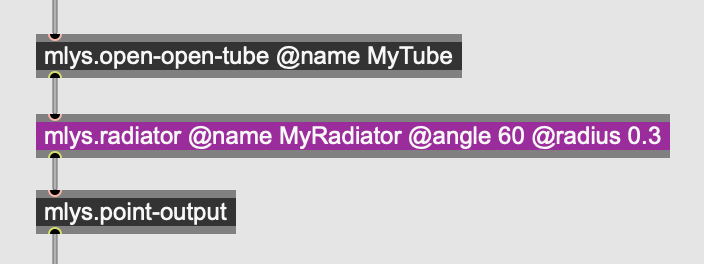Radiator Object
Description
The radiator object simulates the impedance loss resulting from the emission of a sound wave out of a pulsating spherical cap.
Syntax and Default Values
A Radiator object can be created using the following Mlys (Max), mlys.lua, or Lisp syntax:
In Modalys for Max, this object is named mlys.radiator:

In mlys, a single 'normal' access is created on the radiator (with constant position 1), as well as a hidden adhere connection between the radiator and the object.
Also, a mlys.point-output must typically be connected to the outlet of the radiator.
modalys.create_object{kind="radiator", name="myRadiator",
radius = 0.3,
angle = 60,
rho = 1.2, celerity = 340 } -- (default values)
(make-object 'radiator
(radius .3)
(angle 60)
(rho 1.2)
(celerity 340))
Parameters
The parameters (passed as values or controllers) for this object are a little different from regular objects:
- radius: in meters.
- angle: aperture angle in degrees.
- rho: medium density of sound radiation in the propagating medium in kg/m3.
- celerity: swiftness/speed of the sound in the propagating medium in m/s.
For this object, you can control the radius of the sphere, the aperture angle, the medium density and the celerity of sound in that propagating medium. To simulate propagation in air (room temperature at sea level), you should use an air density value of 1.2 kg/m3 for rho, and the speed of sound in air, 340 m/s, for celerity.
Accesses
A radiator can be accessed only in the 'normal' direction:
(make-access my-radiator (const 1) 'normal)
The 'radiator object is designed to be adhered to an access which will be used as a point-output, and the radiator's access used instead of the access on the vibrating object. Here is a basic example:
(setq my-resonator (make-object 'mono-string))
(setq resonator-out (make-access my-resonator (const .695) 'trans0))
(setq my-radiator (make-object 'radiator (angle 90) (radius 3e-2)))
(setq radiator-acc (make-access my-radiator (const 1) 'normal))
(make-connection 'adhere resonator-out radiator-acc)
(make-point-output radiator-acc)
★